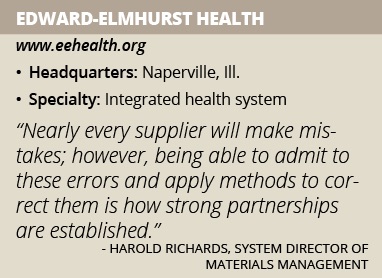Edward-Elmhurst Health
Edward-Elmhurst Health maintains strong partnerships through constant communication and collaboration. By Bianca Herron
Comprised of three hospitals – Edward Hospital, Elmhurst Hospital and Linden Oaks Behavioral Health – Edward-Elmhurst Health is one of the largest integrated health systems in Illinois. Created in 2013 with the merger of Edward and Elmhurst hospitals, the system today has more than 50 outpatient locations that reach more than one million people in the Chicago area.
As the system director of materials management, Harold Richards brings 25 years of experience to his role and oversees nearly $335 million in operating expenses for the system. “Edward-Elmhurst Health has more than 1,900 physicians on staff, and has nearly 60 full-time employees through the materials management division,” he says. His division oversees central distribution, shipping and receiving, courier services, purchasing, contracting and the system’s business center.
Richards notes that it can be challenging to attract not only qualified candidates, but also motivated employees. “We want our talent to be able to connect the value of our services to the organization,” he explains. “The supply chain is a service-driven department that impacts the entire organization and patient care. That’s why during the hospital’s new employee orientation, new hires often get a new perspective of healthcare and the reason why we serve.”
Understanding the value of serving the community gives people an opportunity to see themselves as part of it, Richards notes. And, he adds, being a part of a great organization and contributing to its success make it easier to motivate staff.
“The supply chain’s contribution to patient care is often unseen, so engaging with staff goes a long way,” he notes. “Many great ideas and easy wins come from frontline staff that is locked-in and committed.”
Close Collaboration
 Edward-Elmhurst uses several metrics to measure its supplier performance, including product availability, percentage of invoice discrepancies, freight factors and onsite vendor compliance. “I also strongly believe in simple trust factors,” Richards says. “Nearly every supplier will make mistakes; however, being able to admit to these errors and apply methods to correct them is how strong partnerships are established.”
Edward-Elmhurst uses several metrics to measure its supplier performance, including product availability, percentage of invoice discrepancies, freight factors and onsite vendor compliance. “I also strongly believe in simple trust factors,” Richards says. “Nearly every supplier will make mistakes; however, being able to admit to these errors and apply methods to correct them is how strong partnerships are established.”
Strong communication is also important in not only building strong partnerships, but also when challenges arise in the market. “How many times do you hear of price points going down due to lower energy/fuel costs?” Richards asks. “There needs to be language incorporated within your terms and conditions for price protection, [as well as] upfront discussions around suppliers’ SG&A costs, and their management strategies to drive out cost on their side. This should be the responsibility of all trusted trading partners.”
In addition, Richards notes, “Understanding the trends is important, but applying them should be based on the needs of your organizations. There should always be a strategic discussion on how things will be perceived while planning.
“The supply chain should always be connected and in sync regardless of the size of your organization.”
One of the planning and risk management strategies Richards relies on is the hospital’s non-salary expense reduction committee and product utilization review. “This committee gives us a forum to discuss top strategic saving initiatives outside of standard group purchasing contracts,” he explains. “By analyzing peer utilization by physicians, many times we’re able to renegotiate supply cost with incumbent suppliers, which reduces the burden of long, drawn-out product conversions.”
Looking Forward
Edward-Elmhurst’s history makes Richards proud to be an employee, because the strong brand is viewed as the gold standard of care in Chicagoland.
“We’re always challenging ourselves to get even better and that includes technology as well,” he says. “It is the key to accessing valuable data points, which helps establish roadmaps of success. From the introduction of new implant devices, clinical studies and physician utilization, technology is what gets the right data in front of you to make the best business decision. Technology today needs to be nimble and able to adapt to the fast-pace changes of healthcare.
“With a great staff and partnerships,” Richards concludes, “Edward-Elmhurst Health wants to continue improving the quality of life for the communities we serve and expand our ‘Healthy Driven’ brand for many years to come.”